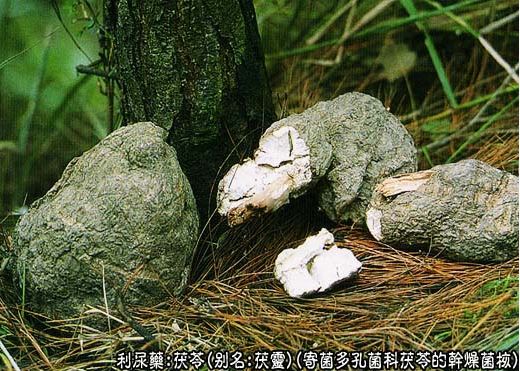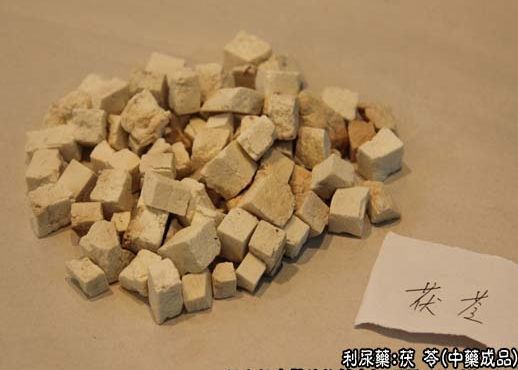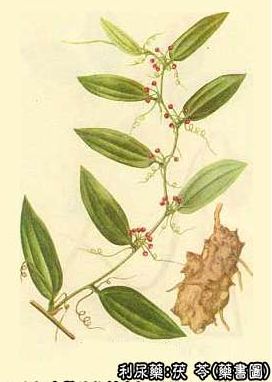


Poria is a commonly used Chinese medicinal herb, classified as a superior product in the Shen Nong’s Materia Medica.
Aliases: Fuling, Futu, Fulings, Fuling, Songyu, Jiangchen Futai, Yunling, Futou, Songshu, Songmushu, Songling.
Source: This product is the dried sclerotium of the fungus Poria cocos (Schw.) Wolf, belonging to the family Polyporaceae. It is harvested mainly from July to September. After excavation, the soil is removed, and it is piled for “sweating” before being spread out to dry until the surface is dry, then “sweated” again, repeating several times until wrinkles appear and most of the internal moisture is lost, then it is dried in the shade, referred to as “Fuling ge”; or fresh Poria is cut according to different parts and dried in the shade, referred to as “Fuling pi” and “Fuling kuai” respectively.
Original Form: The sclerotium is spherical, oval, elliptical, or irregular in shape, measuring 10-30 cm or longer, with varying weights, generally between 500-5000 g. The outer shell is thick and wrinkled, dark brown, soft when fresh but hardens upon drying; the interior is white or light pink and granular. The fruiting body grows on the surface of the sclerotium, is flat, 3-8 cm thick, white, fleshy, and turns light brown when old or dried. The tubes are densely packed, 2-3 mm long, with thin walls, and the openings are round, polygonal, or irregular, measuring 0.5-1.5 cm in diameter, with the edges serrated. Spores are rectangular to nearly cylindrical, smooth, with a pointed tip, measuring (7.5-9)μm × (3-3.5)μm.
Production Areas: Mainly produced in Lijiang, Lanping, Weixi, Jianchuan, and Chuxiong in Yunnan Province; Jinzhai, Huoshan, Yuexi, and Taihu in Anhui Province; Yingshan, Luotian, and Macheng in Hubei Province; Shangcheng, Gushi, and Xinxian in Henan Province; and Wuzhou in Guangxi Zhuang Autonomous Region. Additionally, it is produced in Zhejiang, Guangdong, Hunan, Jiangsu, Fujian, and Jiangxi. It is also distributed in North China, Northwest China, and Northeast China.
Cultivation:
1. Biological Characteristics: Poria is a facultative parasitic fungus, found in the wild at altitudes of 600-1000 m on dry, sunny slopes of trees such as Masson pine, Huangshan pine, red pine, Yunnan pine, and black pine. Spores germinate at 22-28°C, mycelium grows at 18-35°C, and fruiting bodies differentiate and grow at 18-26°C, producing spores. The optimal moisture content for logs is 50%-60%, soil moisture content is 20%, pH is 3-7, and slopes of 10°-35° are suitable for growth. Conditions with large temperature differences between day and night are beneficial for growth.
2. Cultivation Techniques: Poria can be cultivated using logs, tree stumps, and pine needles, but currently, log cultivation is predominant. Select middle-aged pine trees with a diameter of 10-45 cm, cut them down, and strip the bark in intervals of 3-7 cm, 3 cm wide, penetrating 0.5 cm into the wood, known as “bark stripping to retain fibers”. When the pine tree stops exuding resin and the cut sounds hollow, saw the logs into segments of 65-85 cm in length and stack them in a ventilated, sunny place. Choose a sheltered, sunny, slightly acidic sandy slope for the pit, digging a pit with a diameter of 90 cm and a depth of 50-65 cm, with a distance of 33 cm between pits vertically and 17 cm horizontally, and dig drainage ditches around. Place 3-5 logs of varying thickness in layers within the pit. The mycelium, also known as the inoculum, can be of three types: mycelial inoculum, flesh inoculum, and wood inoculum, with mycelial inoculum being the most commonly used. Pure strains are isolated from the sclerotium using PDA culture medium, and the cultivation medium consists of 76% pine sawdust, 22% bran, and 1% each of gypsum and sucrose, with a moisture content of 65%. After sterilization, the pure strain is inoculated and cultured at 25-28°C for half a month, then the bottles are inverted and cultured at 22-24°C for another half month, resulting in mycelial inoculum. Flesh inoculum is obtained by harvesting fresh sclerotia one month before inoculation. Wood inoculum is made from unbranched logs with a diameter of 4-10 cm, cut into 50 cm segments, stacked in pairs, and 250 g of fresh sclerotia is attached to the logs, covered with 3 cm of soil, and after about 60 days, the mycelium can fill the logs. In early spring (March-April), inoculation is done using mycelial inoculum, preferably on sunny days, with fine logs sharpened and inserted into the cultivation bottles, and coarse logs leaning against them, covered with 3 cm of soil. For flesh inoculum, the sclerotia are cut open, and the flesh side is attached to the upper end or side of the material, with the skin facing out. Wood inoculum can be cut into 5-6 cm lengths, leaning against the upper end of the material or cut into two or three segments and placed in the middle of the material.
3. Field Management: During the fruiting period, cracks may appear on the surface, and soil should be added promptly to fill the cracks. Black-winged termites often infest the pine logs; prevention methods include avoiding ant sources when selecting cultivation sites, clearing rotten tree roots during excavation, or setting up bait traps around the cultivation site with pine wood or sugarcane residue to attract and capture termites. Additionally, the introduction of the termite pathogen, Entomophthora, can lead to a 100% kill rate if one ant in the colony is infected.
Identification of Properties: Commercial products are divided into ge ling (pi ling), white ling slices, white ling blocks, red ling blocks, fu shen blocks, white fragments, red fragments, fu shen wood, and fu ling pi, described as follows:
Ge Ling: (pi ling) irregularly shaped or block-like, varying in size, weighing from a few grams to several kilograms. The surface is brown to dark brown, with a thin, rough outer skin and obvious wrinkles or grooves. The texture is dense and heavy, not easily broken. The cross-section is uneven, granular, and angular, with some having cracks or passages for pine roots. The edges are light brown, and the interior is white, with some being light brown. The texture is fine, with no distinct taste, and it sticks to the teeth when chewed.
The best quality is wild Yunnan Poria, also known as Yunling, with a dense texture, rough, dark brown, shiny outer skin, and a white cross-section that is firm and fine, sticking strongly to the teeth when chewed.
White Ling Slices: Thin slices cut from ge ling after removing the outer skin, selected for their white, fine, and firm flesh, approximately 1 mm thick, with a length and width of over 3 cm (those with a reddish hue are called red ling slices).
White Ling Blocks: Thick, flat square blocks cut from ge ling after removing the outer skin, approximately 3-4 mm thick, with a length and width of about 3-4 cm, including those with edges that are not perfectly square but longer than 1.5 cm.
Red Ling Blocks: Similar in shape to white ling blocks but with a reddish or yellowish hue in the flesh.
Fu Shen Blocks: Similar in shape to white ling blocks, but each piece must contain a segment of fine pine root, with a maximum diameter of 1.5 cm, the same thickness as the ling blocks, and light, decayed wood.
White Fragments: Fragments left over from processing white ling slices and blocks, in a fragmented form, with a white color.
Red Fragments: Similar in shape to white fragments but with a reddish-yellow color.
Fu Shen Wood: Coarse pine roots that have grown around Poria, varying in length, generally around 30 cm or less, with a diameter of about 2.5 cm, often bent and resembling decayed wood, yellow-brown or brown in color, light and not showing bark layers, with natural attached parts of Poria.
Fu Ling Pi: The outer skin removed during the production of ling slices and blocks, in thin, block-like pieces of varying sizes, with a brown surface and a red-white inner wall, soft in texture.
Main Components: Contains Poria polysaccharides, poria acid, proteins, fats, lecithin, histidine, choline, ergosterol, and potassium salts.
Pharmacological Effects:
1. Diuretic Effect: A decoction of 3 grams of Poria or the commonly used clinical dosage does not have a diuretic effect on healthy individuals. Intravenous injection of 0.048 g/kg of decoction in dogs does not increase urine output, nor does it have a significant effect on rats or rabbits. However, its alcohol extract injected into the abdominal cavity of rabbits or its water extract in chronic experiments shows diuretic effects. The decoction can promote sodium excretion in adrenalectomized rats, indicating that the diuretic effect of Poria warrants further research. Poria contains 97.5 mg% of potassium; calculated from a 30% water decoction, it contains 0.186 mg/mL of sodium and 11.2 mg/mL of potassium, thus the promotion of sodium excretion is not related to its sodium content (which is too low), while the increase in potassium excretion is related to its high potassium salt content.
Wuling San shows significant diuretic effects in dogs with chronic ureteral fistula (intravenous injection), healthy individuals, and rabbits (oral decoction), with increased excretion of sodium, potassium, and chloride in dogs. However, the main diuretic ingredients in Wuling San are Gui Zhi, Ze Xie, and Bai Zhu. Reports indicate that even at a dosage of 1 g/100 g, Wuling San decoction does not demonstrate a diuretic effect in rats.
2. Antibacterial Effect: No antibacterial effect of Poria was found in vitro. The ethanol extract can kill Leptospira, while the water decoction is ineffective.
3. Effects on the Digestive System: Poria has a direct relaxing effect on the isolated intestinal segments of rabbits and can prevent ulcers formed by pyloric ligation in rats, as well as reduce gastric acid.
4. Other Effects: Poria can lower blood sugar levels; tinctures and infusions can inhibit the isolated heart of toads, while ether or ethanol extracts can strengthen heart contractions. It does not have an antiemetic effect on vomiting induced by digitalis.
Toxicity: Carboxymethyl Poria polysaccharides have low toxicity, with a median lethal dose of 3.13 g/kg when injected subcutaneously in mice. No significant toxic reactions were observed in acute and subacute toxicity tests in dogs. However, after administering a large dose (500 times the common human dosage), there was a significant weight suppression in mice during the first two weeks, with an increase in total white blood cell count and a slight increase in GPT.
Effects and Functions:
1. Diuretic: Animal experiments confirm its diuretic effect, but it is not as effective as Mu Tong or Zhu Ling.
2. Nourishing: Traditional Chinese Medicine believes that Poria has a tonifying nature, capable of strengthening the spleen and benefiting the middle, possibly related to its nutritional components.
3. Sedative: Although the sedative effect of Poria is not as strong as that of Fu Shen, it can still be used for calming and soothing the spirit.
Processing:
Poria: Soak in water, wash, drain, steam, slice, and dry.
Red Poria: Take Poria blocks, spray with clean water, slightly moisten, and evenly sprinkle with fine red mercury powder, mixing repeatedly until the surface is coated with the powder, then dry (30 taels of red mercury powder for every 100 jin of Poria blocks).
Taste and Properties: Sweet, neutral.
Meridians Entered: Enters the Heart, Spleen, Stomach, Lung, and Kidney meridians.
Functions: Promotes urination and drains dampness, benefits the spleen, and calms the heart.
Indications: Qi deficiency, labor injury, edema, phlegm-dampness, vomiting, diarrhea, nocturnal emissions, heat strangury, palpitations, forgetfulness, and other symptoms.
Clinical Applications:
1. Used to treat edema and difficulty urinating, taking advantage of its diuretic properties. It is suitable for general edema, especially in cases of cold or concurrent spleen and stomach deficiency, and can be combined with Ze Xie and Zhu Ling to enhance diuretic effects. For those with Yang deficiency, add Gui Zhi or Rou Gui to promote Yang (i.e., enhance blood circulation). Adding Gui Zhi or Rou Gui to diuretic formulas is to promote blood circulation and enhance diuresis, known as “Qi moves water, water moves with Qi,” such as in Wuling San, which is suitable for mild edema. Experiments have shown that Wuling San has a strong diuretic effect, increasing urine output by 112%.
2. Used to treat phlegm-dampness. Traditional experience states, “Poria must be used for phlegm-dampness.” It takes advantage of its diuretic and spleen-benefiting effects. Generally, Ling Gui Zhu Gan Decoction is used as the main formula. If phlegm-dampness is in the stomach (upper abdominal distension, water sound in the stomach, vomiting clear phlegm), add Ban Xia and Sheng Jiang, or use Poria Decoction; if phlegm-dampness is in the lung (cough, excessive phlegm, difficulty breathing), add Chen Pi, Ban Xia, and Chuan Bei.
3. Used to strengthen the spleen and transform dampness, treating digestive disorders caused by spleen and stomach deficiency, upper abdominal distension, reduced appetite, and spleen deficiency diarrhea. Its effects are twofold: nourishing and regulating the middle; and promoting urination and draining dampness, thus reducing intestinal moisture, making loose stools thicker. For those with stomach Yang deficiency (equivalent to insufficient digestive function), Poria can be used, but it should be combined with Dang Shen, as traditional experience states, “Poria can unblock stomach Yang,” and “for those with stomach Yang deficiency, Shen and Poria must be used together.” In summary, for those with poor appetite, digestive disorders, or post-meal vomiting or diarrhea, Poria can be used along with other spleen-strengthening and Qi-regulating herbs, such as Shen Ling Bai Zhu San. If diarrhea is caused by acute digestive disorders, it can be combined with Cang Zhu and Yin Hua.
4. Used for calming and soothing the spirit. For those with palpitations and insomnia, Poria can be combined with Suan Zao Ren, Yuan Zhi, Bai Zi Ren, and Wu Wei Zi, such as in Bu Xin Dan (commercial preparation).


Scan the QR code | Follow us
Disclaimer: The content published and shared by this public account is for public sharing and discussion purposes only. Some content is sourced from the internet for reference only and does not represent the position of the company or the public account. Please discern carefully. The various prescriptions and formulas mentioned are for reference and learning only and should not be used as a basis for diagnosis and treatment. Please do not use them blindly. This public account does not bear any responsibility for any consequences arising from this. Additionally, if there are any issues regarding the content, images, copyright, or other matters, please contact us, and we will promptly correct or delete them.

